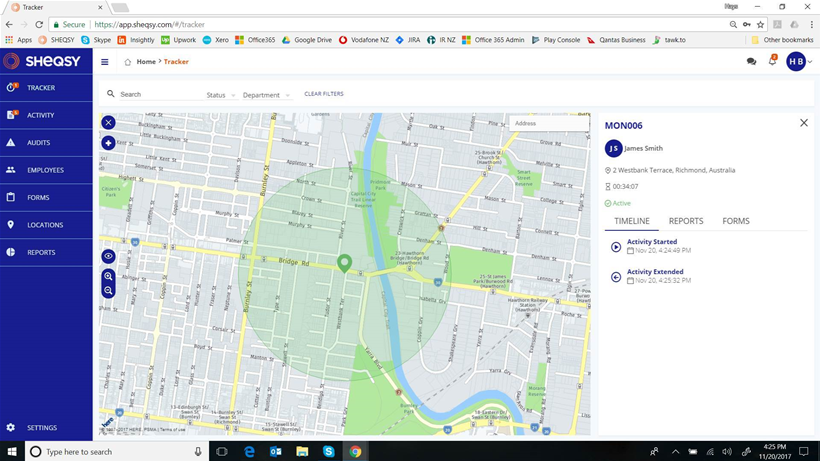Auckland-based startup SHEQSY has developed a cloud platform and associated smartphone app to improve safety for people working alone in the field.
The SHEQSY (the name derives from safety, health, environment, quality and security) platform allows organisations to monitor lone workers in higher risk environments, confirm periodically their wellbeing, receive alerts if a worker is under duress and ensure workers have safely completed activities within the allocated time.
The worker or management can specify a geofenced zone within which a worker is expected to be operating and an alarm will be raised if the employee has not left the geofence in the allocated time and fails to extend the activity duration within a period set by the company.
SHEQSY comprises the cloud platform, a web-based interface for business administrators and iOS and Android apps for workers in the field.
SHEQSY director Hays Bailey said the concept had been born from in-vehicle tracking services that are used by enterprises worldwide to track millions of vehicles, but which provide no support for workers once they leave the vehicle.
“There was an obvious gap in the market for understanding where staff are when they are out of the vehicle, and a lot of lone worker products are very safety and worker centric – they can trigger a duress alarm but they don’t provide any return on investment of any real value to the business,” he said.
“We are going after the market where organisations don’t have any solution for their lone workers and have been reluctant to put anything in because there is no return to the business for spending on that safety initiative.
“SHESQY enables them to meet that obligation around chain of responsibility for lone workers and provides information such as which customers they’ve visited, how long they were at the customer location, how many jobs they did for the day. Then they could look at integrating payroll or billing.”
Bailey acknowledged there would be some overlap with existing systems but said there were many situations where staff used their own or pooled vehicles, and some reluctance to always-on tracking.
He said SHESQY could be in an off mode, except for a panic alarm. “We have a feature called quick panic where if you sweep across the screen of the phone it will expose a panic button that will trigger a message via email or SMS or contact a monitoring centre, as the company chooses.”
SHEQSY is registered in New Zealand and has offices in Auckland and Melbourne, but Bailey expects its main market to be Australia. “We are talking to potential partners, such as OSH [occupational health and safety] consultants. They already offer clients solutions such as document management, training and certification management and risk management.
“We are doing a pilot with a large real estate company in New Zealand. They have workers who go to meet people at rental properties who they might have had no previous relationship with.”
Customers will also be able to subscribe direct from the SHEQSY web site. “We will soon have the plans on the web so that people will be able to sign up and subscribe,” Bailey said.
At present SHEQSY is a one-size-fits-all product and while the company does not plan do customised versions, Bailey said it was receptive to incorporating requested functionality that would have general appeal.
“We have six to eight full-time developers and being a small business we have a lot of flexibility in our roadmap so if someone comes to us with an idea and we think it is something that has value for the rest of our customers we would definitely look at developing it. We do have flexibility but at the moment we are trying to offer something with very broad applicability.”
SHEQSY is currently self-funded and is not presently looking for additional funding. “'We launched a couple of months ago and have trial customers, we want to get our customer numbers up before looking for external funding,” Bailey said.






